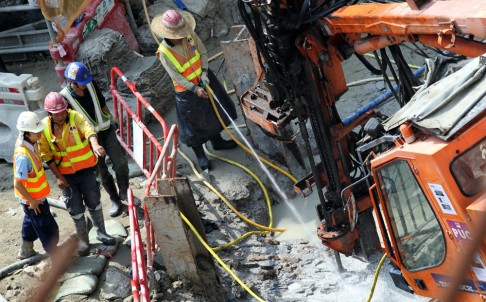
Hong Kong facing shortage of 10,000 construction workers - and MTR is suffering
As mega projects put strain on available manpower, MTR is among companies feeling the pinch
The race is on for developers and contractors to find 10,000 construction workers that Hong Kong needs in the next four years - and the delay-plagued MTR is already feeling the pinch.

"A number of mega projects, including railways, are currently under way in Hong Kong, and the prevailing labour shortage is common to the construction industry," an MTR spokesman said.
"The corporation has been working with the government and the industry to address the labour shortage issue."
Contractors for the government's two biggest projects - the Hong Kong-Zhuhai-Macau bridge and the Central-Wan Chai bypass - have however been "generally able" so far to find enough workers locally, except for some aspects of the bridge that require specialist skills.
The Construction Industry Council says there are about 320,000 registered construction workers but only about 70,000 are active.
It has estimated that the city needs 10,000 additional workers in the coming four years.
Questions have hung over whether some of the big public projects can be completed on schedule since the MTR announced in April that construction of its HK$67 billion high-speed rail link to the border would be delayed to 2017.
Although the MTR said the delay was caused by damage to a tunnel-boring machine and tougher-than-expected geological conditions at the West Kowloon terminus, it admitted that it still had not hired enough workers for its five railway projects.
The spokesman said efforts had been made to improve employment and working conditions to attract younger people as well as experienced workers to join or return to the construction industry.

"The contractors have to arrange in timely fashion for the required workforce and recruit the necessary types and numbers of construction workers according to the programmed works," the departments said.
"To date, the contractors are generally able to employ the required level of workforce locally, except for some trades [on the bridge project] which require specialist skills."
They said about 250 workers were employed on another major project, the Liantang-Heung Yuen Wai border crossing, and the contractors so far had not needed to apply for imported workers.

"It is difficult to offer this training because we need to find a hill to do so. We cannot do this training in the classroom," he said.
He added that Hongkongers did not like the job as they found working in a dark tunnel a "psychological challenge".
On top of the lack of construction workers there is a shortage of engineers, according to Dr Daniel Ho Chi-wing, associate professor in the University of Hong Kong's real estate and construction department.
Fresh engineering graduates received monthly salaries of HK$16,000 two years ago.
Now they were earning HK$19,000, he said.
"And some surveying firms are now hiring people such as social-science graduates, who have not studied surveying at all, and giving them on-the-job training," Ho said.
"The demand is now huge. I haven't seen such huge demand since the peak in the 1990s."
Construction at another mega project, the West Kowloon Cultural District, is slowly getting into gear with preliminary work on the Xiqu Centre for Chinese opera and the M+ museum.
A spokesman for the West Kowloon Cultural District Authority said about 100 workers had been employed for foundation work at the Xiqu Centre, where it is estimated that 400 to 500 workers will be needed at the peak. Site-preparation work for the M+ museum began in April and the average daily number of workers needed was 10 to 14, the spokesman said.

